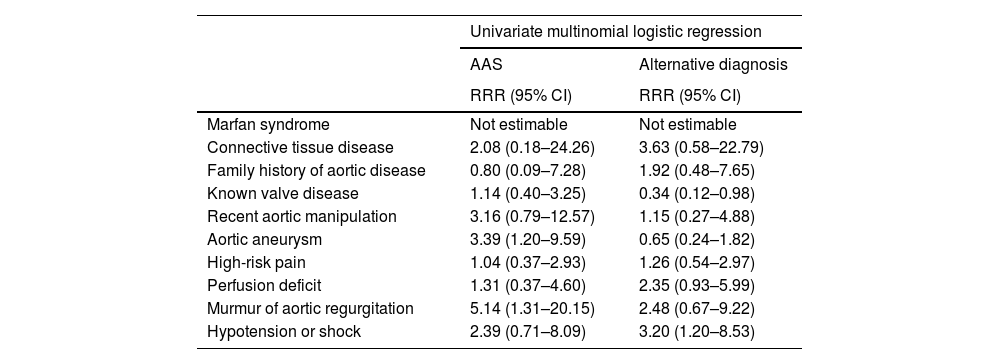Acute aortic syndrome (AAS) is uncommon and difficult to diagnose, with great variability in clinical presentation. To develop a computerized algorithm, or clinical decision support system (CDSS), for managing and requesting imaging in the emergency department, specifically computerized tomography of the aorta (CTA), when there is suspicion of AAS, and to determine the effect of implementing this system. To determine the factors associated with a positive radiological diagnosis that improve the predictive capacity of CTA findings.
Materials and methodsAfter developing and implementing an evidence-based algorithm, we studied suspected cases of AAS. Chi-squared test was used to analyze the association between the variables included in the algorithm and radiological diagnosis, with 3 categories: no relevant findings, positive for AAS, and alternative diagnoses.
Results130 requests were identified; 19 (14.6%) had AAS and 34 (26.2%) had a different acute pathology. Of the 19 with AAS, 15 had been stratified as high risk and 4 as intermediate risk. The probability of AAS was 3.4 times higher in patients with known aortic aneurysm (P = .021, 95% CI 1.2–9.6) and 5.1 times higher in patients with a new aortic regurgitation murmur (P = .019, 95% CI 1.3–20.1). The probability of having an alternative severe acute pathology was 3.2 times higher in patients with hypotension or shock (P = .02, 95% CI 1.2–8.5).
ConclusionThe use of a CDSS in the emergency department can help optimize AAS diagnosis. The presence of a known aortic aneurysm and new-onset aortic regurgitation were shown to significantly increase the probability of AAS. Further studies are needed to establish a clinical prediction rule.
El síndrome aórtico agudo (SAA) es poco frecuente y difícil de diagnosticar, con una gran variabilidad en su cuadro clínico inicial. Desarrollar un algoritmo informático, o un sistema de apoyo a las decisiones clínicas (SADC), para el manejo y la solicitud de estudios de diagnóstico por la imagen en el servicio de Urgencias, en concreto de una tomografía axial computarizada (TAC) de la aorta, ante la sospecha de SAA, y determinar el efecto de la implantación de este sistema. Determinar los factores asociados a un diagnóstico radiológico positivo que mejoren la capacidad predictiva de los hallazgos de la TAC de aorta.
Material y métodosTras desarrollar e implementar un algoritmo basado en la evidencia, se estudiaron presuntos casos de SAA. Se utilizó la prueba de la χ2 para analizar la asociación entre las variables incluidas en el algoritmo y el diagnóstico radiológico, con 3 categorías: sin hallazgos relevantes, positivo para SAA y diagnósticos alternativos.
ResultadosSe identificaron 130 solicitudes; 19 (14,6%) tenían SAA y 34 (26,2%) tenían otra enfermedad aguda. De las 19 con SAA, 15 habían sido estratificadas como de alto riesgo y 4 como de riesgo intermedio. La probabilidad de SAA era 3,4 veces mayor en los pacientes con aneurisma aórtico conocido (p = 0,021, IC del 95%: 1,2–9,6) y 5,1 veces mayor en los pacientes con un nuevo soplo por insuficiencia valvular aórtica (p = 0,019, IC del 95 %: 1,3–20,1). La probabilidad de tener una enfermedad aguda grave alternativa fue 3,2 veces mayor en los pacientes con hipotensión o choque (p = 0,02, IC del 95 %: 1,2–8,5).
ConclusiónEl uso de un SADC en el servicio de Urgencias puede ayudar a optimizar el diagnóstico del SAA. Se demostró que la presencia de un aneurisma aórtico conocido y de insuficiencia valvular aórtica de nueva aparición aumentan significativamente la probabilidad de SAA. Se necesitan más estudios para establecer una regla de predicción clínica.












